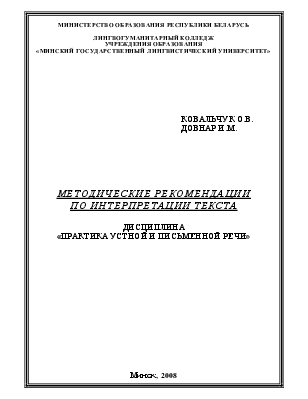











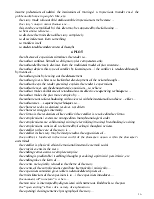

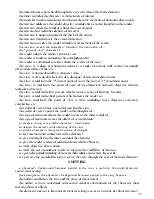

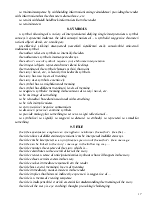

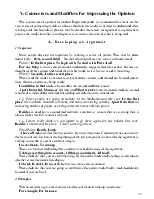






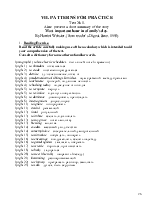








МИНИСТЕРСТВО ОБРАЗОВАНИЯ РЕСПУБЛИКИ БЕЛАРУСЬ
ЛИНГВОГУМАНИТАРНЫЙ КОЛЛЕДЖ
УЧРЕЖДЕНИЯ ОБРАЗОВАНИЯ
«МИНСКИЙ ГОСУДАРСТВЕННЫЙ ЛИНГВИСТИЧЕСКИЙ УНИВЕРСИТЕТ»
МЕТОДИЧЕСКИЕ РЕКОМЕНДАЦИИ
ПО ИНТЕРПРЕТАЦИИ ТЕКСТА
ДИСЦИПЛИНА
«ПРАКТИКА УСТНОЙ И ПИСЬМЕННОЙ РЕЧИ»
Минск, 2008
Рецензент: , преподаватель дисциплины «Литература стран изучаемого языка»
Рецензируемая работа была подготовлена преподавателями иностранного языка Лингвогуманитарного колледжа Учреждения образования «Минский государственный лингвистический университет» и .
Авторы методического пособия систематизируют основные литературоведческие понятия и термины (сюжет, конфликт, тема, идея, метафора, метонимия, эпитет, каламбур и др.), предлагают ряд существенных рекомендаций (план анализа, ключевые вопросы, фразы для выражения собственного мнения и т.д.), необходимых для детального анализа произведений художественной литературы. реализация авторских идей находит отражение в 8 разделах, материал которых существенно дополняет ряд современных работ по проблемам изучения и толкования художественных текстов, являясь систематизированным образцом их комплексного анализа.
Логика структурной организации методического пособия обуславливает доступность усвоения предлагаемой информации: теоретическую часть работы существенно дополняет практический материал (примеры средств художественной выразительности, образцы художественных текстов), на основе которого проиллюстрированы ведущие литературоведческие положения.
весьма профессионально изложенный теоретический и практический материал будет полезен учащимся и преподавателям педагогических колледжей, гимназий, лицеев, студентам факультетов гуманитарного профиля.
Рассмотрено и одобрено на заседании предметно-цикловой комиссии иностранных языков.
Протокол №4 от 12.12.2007 г.
Contents
I. Talking About Stories. Theoretical Preliminaries.
II. The Plan for Rendering the Story
III. Some Helpful Questions for Further Text Analysis
IV. Useful Vocabulary for Detailed Text Analysis
V. Connectors and Modifiers for Expressing the Opinion
VI. Elements of Style
VII. Patterns for Practice
VIII. List of Works Used
|
I. Talking About Stories. Theoretical Preliminaries.
When discussing stories or extracts there are certain aspects which you are supposed to regard. It is useful to know and to be able to use them. They will make it easier for you to talk about stories.
1. If you deal with an extract begin your discussion with saying a few words about its origin, naming the writer and the title of the story or the novel it is taken from.
2. The impact of a literary work depends on all its elements. Among them plot plays an important role. Plot refers to the sequence of events or actions in a story. Most stories and novels have plots. But there are some which have no plots (e.g. stories and poems describing nature, the so-called “novels of ideas” and stories presenting the stream of consciousness).
The components of the plot structure are
- the exposition (where the author introduces the theme, the characters and establishes the setting)
- complications (actions, thoughts, feelings)
- the climax (the key event, the crucial moment of the story)
- the denoement or resolution (where the fate of the main characters is clarified and some conclusions are suggested)
It should also be noted that the intensity of the impression depends on the order in which the writer presents the information included into the story (the so called “presentational sequencing”). There are several devices of presentational sequencing
- retardation (the withholding of information until the appropriate time, it heightens suspense)
- flashbacks (scenes of the past inserted into the narrative)
- foreshadowing (a look towards the future, a remark or hint that prepares the reader for what is to follow)
3. At the heart of the plot is conflict – the opposition of the characters or groups of characters to each other or to something. The story may be based on several conflicts:
external –
a) man against man
b) man against nature
c) man against society, social order!
d) conflict with poverty inequality
internal – “man against himself”
4. The plot with its characters, actions and settings forms the so-called ‘surface content’ of a literary work, which is represented in concrete individuals, situations and actions. It may entertain and keep the reader curious. Some read only to learn what happens next. But a skilled reader discovers what lies beyond the surface content, he looks for the theme.
Уважаемый посетитель!
Чтобы распечатать файл, скачайте его (в формате Word).
Ссылка на скачивание - внизу страницы.